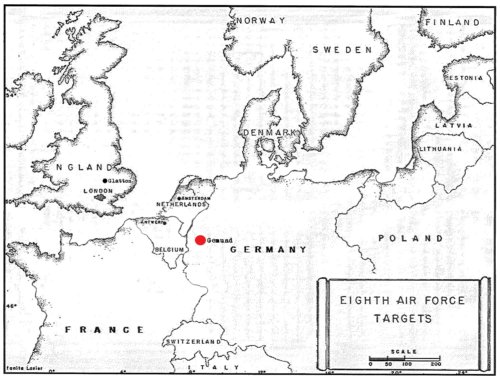MISSION NO. 161
GEMUND, GERMANY
19 DECEMBER, 1944
THE ARDENNES OFFENSIVE
THE BATTLE OF THE BULGE
The German meteorologists had correctly predicted that the weather in western Europe would be unfavorable for flying during the middle and latter part of December.
The German ground forces mounted what proved to be their last major offensive of the war, the Ardennes Offensive, the Battle of the Bulge. Armed with new Panzer tanks and a beefed up infantry, the Germans devised a plan to cut a northwesterly path through Belgium and divide the Allied forces. With conditions on the ground predicted to be mud, snow and fog, plus unfavorable flying weather, the Germans mounted their attack on 16 December, as warming weather drew a dense mist from the snow that covered a front extending fifty miles in width. The Allied command had not anticipated such an attack, and with the unfavorable weather conditions, it was three days later before the bombers could become airborne to offer air support.
On 16 December, extremely poor weather conditions practically grounded the entire Eighth Air Force. The 1st Division abandoned their planned mission. The next two days saw a repeat of 16 December. The poor weather conditions prevented any meaningful air operations.
MISSION NO. 161
GEMUND, GERMANY
19 DECEMBER, 1944
Flying conditions were unfavorable; however, the 94th Combat Wing’s target was tactical in nature, designed to impede the German offensive. The Group committed thirty-six craft to the operation, comprising the 94th C Combat Wing with Major James A. Maguire as Air Commander.
The Group assembled at briefed altitude. Fourteen aircraft failed to take off, six of which were in the lead and eight in the low squadron. The lead and low squadrons therefore combined to form one squadron. The high squadron of twelve craft was intact.
The route over England was not flown as briefed. The Group was late leaving the Buncher because of difficulties encountered during Group assembly, and departed directly to Wing assembly.
The Group maintained formation and was in proper position in Division formation. Division assembly line was flown approximately as briefed. Course over enemy territory was flown as briefed. It was necessary to climb to briefed altitude plus 1,000 feet, because of heavy contrails and clouds. Bombing was done by means of G-H equipment, in squadron formation. The lead squadron swung wide at the IP A considerable interval existed between the squadrons because the high squadron had executed a 360 degree turn. Bombs were released from 24,800 feet. Bombing results were unobserved due to ten tenths cloud coverage over the target area.
Course from the target was flown approximately as briefed and in proper position in Division formation. The Group was diverted to Portreath because Glatton was closed in, although six aircraft did manage to land at Glatton. The Group landed without incident and suffered no losses. It was three days before the other craft could return to the base. One crashed on landing. On 23 December, the 1st Air Division relayed a message from the Supreme Commander of the Allied Expeditionary Forces, General Dwight D. Eisenhower, commending all units for their brilliant work, but urging them to rise to new heights of courage, of resolution and of effort, and concluded by saying,
“We will, with GOD’S help, go forward to our greatest Victory”.
General Lacey of the 94th Combat Wing extended Christmas greetings and appreciation for making the 94th Combat Wing one of the finest in the United States Army Air Force. On 23 December, the following message from Colonel Rogner was published:
“I wish to extend my personal Christmas greeting to all members of this command and to express a desire that every Officer and every Enlisted Man of this base enter into the religious and social activities of the season. “This is a lime when good spirit prevails and a proper time to ask God to help us, and to lead us to a great victory and to ask His help in achieving the peace.
“Christmas means something dIfferent to each one of you. In the years to come, Christmas ’44 will be remembe red as your Christmas as a member of the 457th Bomb Group spent in England. Let ‘s make it a good memory and in turn strengthen the bonds that make the 457th the Group that it is.”
